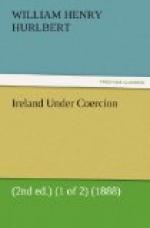At Ennis I was met by Colonel Turner, to whom I had written, enclosing a note of introduction to him. With him were Mr. Roche, one of the local magistrates, and Mr. Richard Stacpoole, a gentleman of position and estate near Ennis, about whom, through no provocation of his, a great deal has been said and written of late years. Mr. Stacpoole at once insisted that I should let him take me out to stay at his house at Edenvale, which is, so to speak, at the gates of Ennis. Certainly the fame of Irish hospitality is well-founded! Meanwhile my traps were deposited at the County Club, and I went about the town. I walked up to the Court-house with. Mr. Roche, in the hope of hearing a case set down for trial to-day, in which a publican named Harding, at Ennis—an Englishman, by the way—is prosecuted for boycotting. The parties were in Court; and the defendant’s counsel, a keen-looking Irish lawyer, Mr. Leamy, once a Nationalist member, was ready for action; but for some technical reason the hearing was postponed. There were few people in Court, and little interest seemed to be felt in the matter. The Court-house is a good building, not unlike the White House at Washington in style. This is natural enough, the White House having been built, I believe, by an Irish architect, who must have had the Duke of Leinster’s house of Carton, in Kildare, in his mind when he planned it. Carton was thought a model mansion at the beginning of this century; and Mr. Whetstone, a local architect of repute, built the Ennis Court-house some fifty years ago. It is of white limestone from quarries belonging to Mr. Stacpoole, and cost when built about L12,000. To build it now would cost nearly three times as much. In fact, a recent and smaller Court-house at Carlow has actually cost L36,000 within the last few years.
I was struck by the extraordinary number of public-houses in Ennis. A sergeant of police said to me, “It is so all over the country.” Mr. Roche sent for the statistics, from which it appears that Ennis, with a population of 6307, rejoices in no fewer than 100 “publics”; Ennistymon, with a population of 1331, has 25; and Milltown Malbay, with a population of 1400, has 36. At Castle Island the proportion is still more astounding—51 public-houses in a population of 800. In Kiltimagh every second house is a public-house! These houses are perhaps a legacy of the old days of political jobbery.[19] No matter when or why granted, the licence appears to be regarded as a hereditary “right” not lightly to be tampered with; and of course the publicans are persons of consequence in their neighbourhood, no matter how wretched it may be, or how trifling their legitimate business. Three police convictions are required to make the resident magistrates refuse the usual yearly renewal of a licence; and if an application is made against such a renewal, cause must be shown. The “publics” are naturally centres of local agitation, and the publicans are sharp enough




